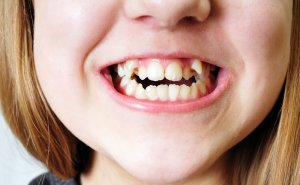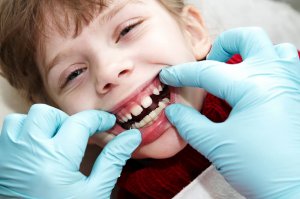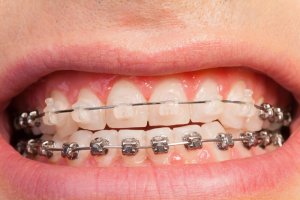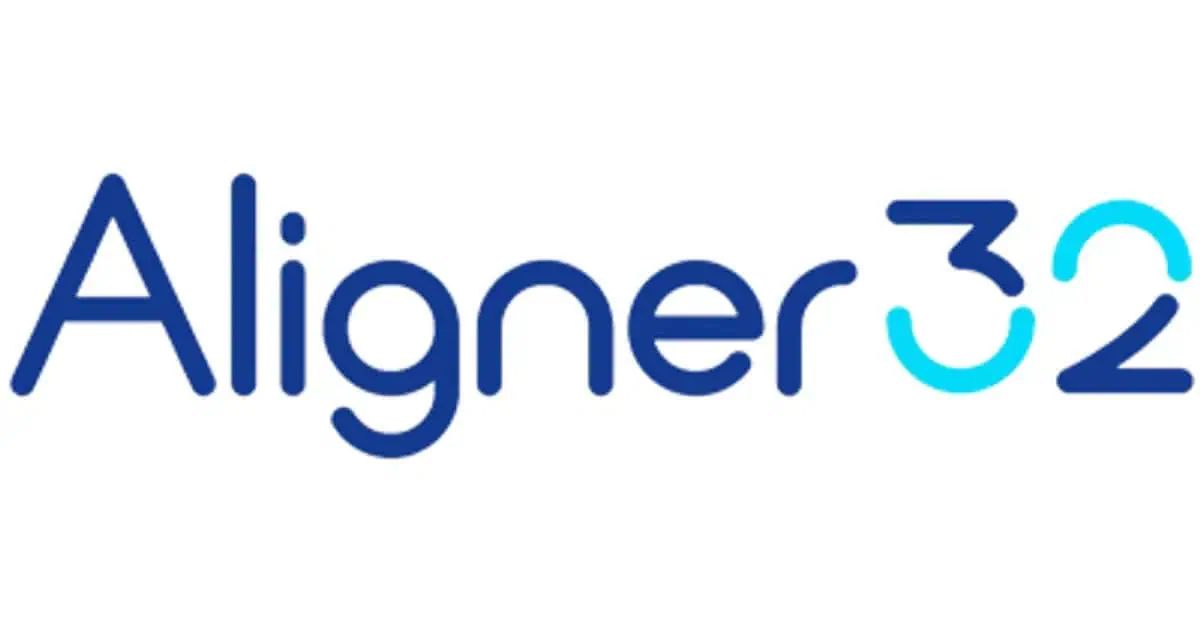An open bite, a type of malocclusion where some of the teeth don’t meet when biting down, often occurs in the transition from milk teeth to permanent teeth. The problem normally corrects itself and doesn’t persist into adulthood. But if a child gets older and still has an anterior open bite then treatment will be needed to avoid problems later in life.
Needing dental work can be worrisome, but our aim is to provide you with all the information you need about open bite treatments so you know what to expect. We’ll talk about:
- Anterior open bite definition
- Posterior open bite definition
- Open bite symptoms
- The problems caused by an open bite
- Open bite teeth treatment options
If you’re thinking of fixing your malocclusion with open bite orthodontics treatment like veneers, braces or surgery then we hope this guide helps you make an informed decision.
In This Article
What’s the definition of an open bite?

An open bite occurs when some of the top and bottom teeth don’t make contact when your teeth are closed. The normal position of the teeth is that the top front teeth sit slightly in front of the bottom ones and a little bit lower, with the molars at the back connecting with each other. With an open bite, the teeth don’t come together properly and there is a visible gap between the top and bottom jaws.
It’s possible to have an open bite along with another type of bite problem such as an overbite, underbite or crossbite. You can read more about each of these in our separate articles.
Anterior open bite
Anterior open bite is defined as the front teeth not connecting properly when the back teeth have already made contact. Between 1.5% and 11% of the population may have an open bite of some degree, depending on the country.
The opposite is a posterior open bite, where the back teeth don’t touch when the front teeth are closed. This kind of malocclusion isn’t so common, but it can sometimes happen during treatment with braces or elastics for open bite. Your dentist will spot it and take steps to correct it if the issue arises.
What are the symptoms of open bite?
An open bite is usually easy to spot just by looking at your teeth when you bite down naturally. You’ll see a gap between the top and bottom teeth, either at the front or on one or both sides.
In cases where the condition is caused by a problem with the jawbone, it’s often because there is too much bone growth at the back of the upper jaw. This pushes the teeth out of alignment, causing the front teeth to protrude (known as an overjet).
An open bite exists when your back teeth touch before your front teeth come together. There’s a gap between the front upper and front lower teeth when you’re biting down completely.

An open bite can be due to your inherited jaw growth pattern. It can also be caused by an injury or behavioral factors like thumb sucking.
If left untreated, an open bite can lead to an unflattering appearance in addition to a number of other concerns:
- A lisp or other speech difficulties.
- Excess forces on the back teeth which could cause them to wear down or crack.
- Trouble with biting and chewing food.
- Issues with swallowing.
- Altered saliva flow.
An open bite is treatable at any age, but it’s generally easier and with more options to treat as a child or teen.
Dr. Greg Nalchajian, Nalchajian Orthodontics
Open bite causes
There are a few different reasons why an open bite can develop. These include:

- Being passed down through genes
- A problem with the jawbone
- Milk teeth and adult teeth coming through out of order
- Tongue thrusting
- Thumb, pacifier, pen, or pencil sucking
- Temporomandibular joint problems
Genetic causes are pretty much unexplored by doctors, but if there is a history of problems with jaw development in your family, it is likely your child will have a similar experience.
If the condition is caused by bone issues it will be known as a ‘skeletal open bite’, whereas when it’s caused by actions like tongue thrusting or pacifier-sucking it is a ‘dental open bite’.
Open bite problems
Having an open bite can cause some quite noticeable problems, such as:
- Self-consciousness if your smile isn’t how you would like
- A lisp or other speech impediments
- Increased wear on the back teeth
- Difficulty eating some foods
Open bite problems in children
It isn’t uncommon for infants and young children to have an open bite; it will normally fix itself around the age of four. When your child starts to lose their milk teeth and the adult teeth begin to erupt, it is normal for the teeth to not always meet in the middle.

Once a few of the adult teeth have come through, your dentist can check if the new teeth will be in an open bite pattern and, if so, advise you about the options for correcting it.
If a child sucks their thumb, uses a pacifier too often, or generally spends a lot of time putting things in their mouth, this could affect their bite as their teeth develop too. Here are some tips for helping your child to break a thumb-sucking habit.
Problems due to tongue thrusting
Tongue thrust can be a major cause of open bite. Tongue thrusting means that when you swallow or talk, the tongue thrusts forwards into the mouth. Through this process, the front teeth are gradually forced outwards into an open bite.
Tongue thrusting is common in young children, but they usually grow out of it by the age of four. This article has more detailed information about tongue thrusting. If the habit persists there are treatment options you can pursue, which we’ll discuss below.
Jaw problems
The temporomandibular joint (TMJ) is the hinge that allows your mouth to open. Some people have problems with this joint and so they move their mouth and tongue around to feel comfortable. It may feel more comfortable to rest the tongue quite far forward in the mouth, or between the teeth, but this can push teeth forward and cause an open bite.
The underlying problem that is causing the issues with the jaw joint need to be addressed, along with treatment to fix the open bite problem.
Treatment options

Open bite treatments are common and well understood by dentists and orthodontists. Catching the problem in early childhood increases the chances of being able to fix an open bite without surgery. For adults, open bite surgery is a more likely option.
Your dentist is the best person to tell you about your treatment options. Anyone under 18 years old 0n the CHIP program or Medicaid will most likely receive this treatment for free if it is medically necessary, and the decision to treat adults on Medicaid is based on medical need. You can read Medicaid and Medicare dental insurance for more information.
Open bite braces costs depend on the treatment needed; you can read our guide to braces to discover more about prices for private treatment.
The table below has a brief overview of the various open bite treatment options available according to age. Following this, there is more detail on each of these treatments.
Age | Treatment/intervention options |
0-4 |
|
7-10 |
|
11-17 |
|
18+ |
|
Open bite braces
Treating an open bite with braces is common. The braces will pull teeth back if they are protruding forward and can pull them into proper alignment.
The course of treatment can take anywhere from six months to two years and will need to be followed up with teeth retainers. Wearing retainers is really important to make sure that the teeth don’t go back to their old position.
Below shows open bite before and after braces and intrusion during a two-and-half-year treatment program, so you can really see how open bite braces can change your smile. This treatment is quite drastic because of the amount of work required to correct the patient’s open and crossbite. Not everyone will require this degree of open bite correction, so don’t be alarmed!
Treatment for tongue thrusting
If your open bite is caused by tongue thrusting, you need to treat the cause of the problem as well as the dental issues. The most common treatments are:
- Tongue therapy
- Exercises for the tongue
- Appliances like a tongue crib
A tongue cradle or crib is a little bit like a retainer that attaches to your molars. It puts a barrier across your mouth so the tongue can’t push forwards. Exercises and therapy can be offered through a speech therapist; your GP should be able to refer you if this treatment is available in your area.
Stopping the habit of tongue thrusting won’t correct tooth misalignment, but it will make sure the bite problem won’t get worse or relapse after braces treatment is finished.
Can I achieve open bite correction with Invisalign?
If you’re wondering how to close an open bite without braces, you may want to consider invisible aligners like Invisalign. This is one of the many types of malocclusion that invisible braces are able to help with. These are clear, plastic braces that you change every two weeks or so and over time they move your teeth into the right position.
For many people, however, treatment with Invisalign isn’t an option because it’s so expensive. Fortunately, there are more affordable options like at-home aligners, with brands like Candid, NewSmile, ALIGNERCO and Byte. Take a look at these top brands to see which would be the best match for your needs:
- Most affordable options
- Single and dual arch, day and night options
- Convenient AlignerTracker app
- Free teeth whitening
Aligner32 offers a convenient and affordable way for individuals to straighten their teeth using custom-fit clear aligners. Their service is designed for at-home use, allowing customers to avoid frequent orthodontist visits while still achieving professional-grade results.
Aligner32 provides two main treatment plans tailored to suit different needs:
- All-Day Plan: The All-Day Plan requires 22 hours of daily wear and offers faster results, with treatment lasting between 4 to 6 months.
- Night Wear Plan: The Night Wear Plan is ideal for those who prefer a more flexible routine, requiring just 10 hours of daily wear, typically at night, with a treatment duration of 6 to 8 months.
Both plans are designed to treat a range of orthodontic issues, including crowding, spacing, overbites, underbites, and crossbites.
With affordability in mind, Aligner32’s clear aligners are significantly less expensive than traditional braces, which can cost between $5,000 to $8,000. Customers can also use flexible payment plans, making it easier to manage the cost.
Additionally, Aligner32 offers a free teeth whitening kit with their aligner packages, making the treatment even more appealing. The company emphasizes comfort, convenience, and professional care, making it a popular choice for those seeking a better smile without the high costs and hassle of conventional orthodontic treatments.
- Complete treatment 100% remotely
- Amazing customer service
- Nighttime-only option
- $1,495 or $55/month
NewSmile aligners are made from the clearest Essix plastic and come with a daytime or nighttime-only option to suit you. For just $1,495 you’ll receive everything you need to straighten and whiten your teeth – and maintain your new smile:
- Home impression kit
- Full aligner treatment
- Free whitening
- First set of retainers
- A full refund if you’re not a good fit
NewSmile goes above and beyond to provide a great experience to all their customers, beginning with a live video call to help you with your teeth impressions. Mail these back, and they’ll send a 3D Treatment Preview for you to approve before going ahead.
- Smileie Pro offers hybrid treatment!
- Single-arch treatment option
- Nighttime aligners available
- Free refinements & 2 sets of retainers
- $699 (single-arch) or $999 (dual-arch)
Smileie’s aligner treatment is not only affordable, but flexible too. You have the option of Smileie Pro, which is hybrid treatment that involves in-office visits with a dentist.
That means more accurate, safer and effective treatment or a wider variety of cases.
But you can also opt for single-arch treatment for just your top or bottom teeth, as well as nighttime-only treatment. And whichever package you choose, monthly payments are available.
On top of this, Smileie offers a 100% satisfaction guarantee which includes free refinements if needed. Their aligners are made in the US and treatment takes 4-6 months on average.
Get Smileie Pro for just $1499, or —
Get the best discount on the standard plan, with 100% remote treatment, when you purchase your aligner package up-front, including:
- Home impression kit
- Teeth whitening kit
- Two sets of retainers
- A full refund if you’re not a good candidate
Packages start at $699 for single-arch treatment. Click below to check for current discounts!
- Complete treatment 100% remotely
- 4-6 month average treatment time
- Nighttime-only option
- $770 or $64/month
If you’re looking for the best value aligner package, here it is! For just $895 you’ll get:
- Impression kit
- Full aligner treatment course
- Free teeth whitening kit
- Your first set of retainers
In short, everything needed to straighten your teeth remotely and keep them looking great, with a full money-back guarantee if you’re not a suitable candidate.
This low price doesn’t mean you’re compromising on quality of care, though. ALIGNERCO just choose not to put so much into marketing, and they pass on the savings to their customers. They are also known for their responsive and helpful customer care, which is important when you’re doing things from home.
Nighttime-only aligners are also available for anyone who doesn’t want to wear aligners during the day.
If you’re interested in this type of treatment but not ready to commit just yet, you can begin by just taking a free assessment to check your eligibility. Our guide to the best invisible braces also goes into more detail on this topic.
Can you fix open bite with veneers?
If your open bite is very minor, it may be possible to fix it with veneers. Veneers are a kind of thin tooth covering made from ceramic or composite material. To fit veneers, a small amount of enamel must be scraped off the tooth first. Read our full guide for more details about dental veneers.
Although it’s possible to fix an open bite with veneers, it might just end up masking the problem. Some of the negative aspects of using veneers in this way are:
- Your teeth will look bigger. The veneers will need to be longer than your natural teeth to close the gap.
- More problems with the alignment of your teeth might crop up because of the new forces introduced into your mouth.
- Any future braces or jaw surgery to correct open bite you may need will be harder because the brackets of braces can’t stick well to veneers.
- It probably won’t fix underlying issues such as tongue thrusting, or the increased wear on the back teeth.
Seek advice from your dentist about using veneers to fix your open bite. There is a lot to consider about the long-term future of your oral health.
Saying that, for a very small open bite that doesn’t cause speech or eating problems, this may be a handy way to improve your smile quickly.
How to fix open bite naturally?
If your baby has a bit of an open bite, it’s possible that it will naturally correct as your child’s jaw grows. However, after the age of 4, children and adults will not be able to fix an open bite naturally, professional intervention will be necessary to fix this issue.
Open bite surgery

Depending on the severity of the open bite, surgery may be needed. Adults are more likely to need surgery since the bones have fused and are less easy to move.
Open bite surgery on Medicaid and CHIP is free for under 18s, and if there is a medical need for it, open bite surgery costs may be covered by Medicaid, depending on the state you live in. Because of the practical problems that this condition can cause, it’s worth seeking treatment – even as an adult. If you need open bite jaw surgery, the costs can be between $20,000 to $40,000 for private treatment.
Usually, you will need to wear braces for around one year before jaw surgery, and for another 6 months to a year afterward. You won’t have any scars because all of the work happens inside your mouth, but you’ll be on a liquid diet for a few days after and there is likely to be some swelling. For more information about jaw surgery and what might be covered by your state, you can check out this handy table put together by the Kaiser Family Foundation.
To get some insight into the process of recovery from jaw surgery, and see open bite before and after treatment, you can check out this video:
Open bite surgery risks
As with any surgery, there are some risks involved. However, jaw surgery is pretty common and the healing process is well understood.
Doctors can use computer modeling to map all of the adjustments they will have to make. The process of having your bones broken and plates and screws inserted does sound scary, but the benefits of being able to eat well and have improved speech will be worth it.
Conclusion
Open bites are normally easy to spot when a child is quite young, and corrective steps can usually be taken, such as wearing a tongue crib or undergoing orthodontic work. Open bite braces cost nothing for children under 18 on Medicaid and CHIP if medically necessary, and the associated problems with eating and talking are likely to mean that treatment is deemed necessary.
Adults are assessed on a case-by-case basis, depending on the problems they are experiencing and the state they live in. Those who aren’t eligible for state-funded treatment, or who would prefer not to have metal braces, might be able to use more affordable options like at-home clear aligners. Take the Smile Assessment to find out if you’re eligible.
FAQs
How do you fix an open bite?
The primary way to fix open bite is with traditional braces. In more extreme cases, a palate expander may be necessary, as well as surgery. Your dentist will determine what level of treatment you need. After treatment, if the patient developed the habit of tongue thrusting, therapy may be necessary as well. In very mild cases, it may be possible to treat an open bite with invisible aligners.
What is an open bite?
An open bite happens when the top and bottom teeth don’t meet together in a closed position. Normally, the top front teeth sit just in front of the bottom ones and lower, and the molars connect naturally.
Can Invisalign fix open bite?
Invisalign may be able to fix an open bite if it’s not too severe. Complex cases of open bite are likely to require traditional braces, and perhaps even devices like a palate expander. Surgery may be necessary too.
KFF: Medicaid Benefits: Medical/Surgical Services of a Dentist. Consulted 2 July, 2019.
New Park Orthodontics: What is a tongue crib and how does it help tongue thrusting habits. Consulted 4th June 2019.
WebMD: 9 Ways to Wean a Child off Thumb Sucking. Consulted 4th June 2019.
IOSR Journal of Dental and Medical Sciences: Anterior Open Bite: Review and Management. Consulted 5th June 2019.








